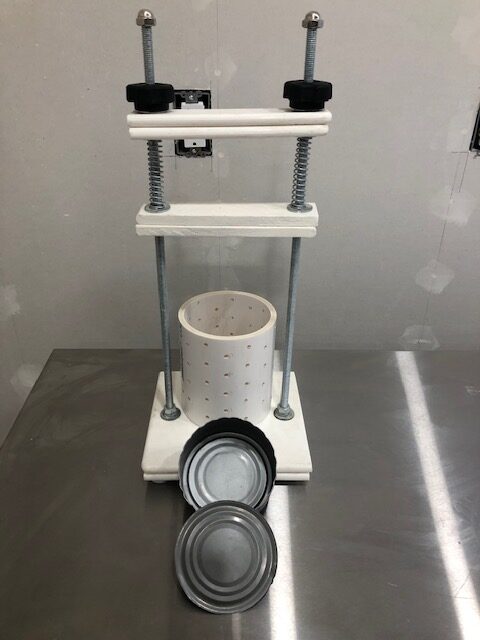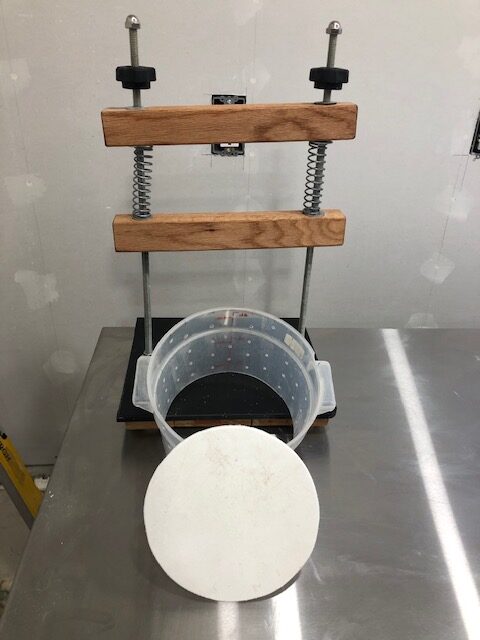Making cheese is a lot of fun because it employs all the elements of culinary cuisine, such as, finding the right ingredients, mixing things just right, and having the fortitude to be patient. This recipe yields about a quart of cheese that ready in either two days or two months. If you want something faster, make Crème Fraiche or Mascarpone (recipes to be posted soon).

Before you start, you’ll need a cheese press for aging. I made mine, from a plastic cutting board, some PVC pipe, and hardware I bought at the home improvement store. If you weren’t lucky enough to have been born an engineer, then 1) you need to talk with God about why he doesn’t like you, and 2) think about how to improvise.

Once you make your first cheese press, it won’t be long before you decide that bigger is better and more heavy duty means more processing efficiency, but that’s and obsession for another day.
You also need cheesecloth to make cheese. You can find this at most grocery stores. However, what they sell is not very good quality so you may want to get some from a cheese supply store on line. You can reuse your cheesecloth so buy good quality may make sense. It makes the cheese making process more enjoyable.
As I mentioned above, the hardest part about making cheese in the modern age is finding unpasteurized milk. Don’t even bother with your big box grocery store, you either have to go directly to the source or a real health food store. When looking at milk, buy whole milk. You can use pasteurized milk in a bind, but it most definitely cannot be “ultra pasteurized” milk, which is 99% of the milk you find in stores. Read the label carefully before buying. If you try to use ultra pasteurized milk you won’t get curds to form. Once you find a milk source, the rest is easy. I get my milk from a dairy farmer who sells fresh pasteurized milk commercially. Technically he’s not allowed to sell me unpasteurized milk, but we worked out a deal. Note: if you want to work out a deal with a kind dairy farmer, you have to make good cheese.
Ingredients
- 1 gallon whole, unpasteurized milk
- 1/2 rennet tablet (or liquid equivalent)
- 2 TBL water if using tablet
- 1/2 cup buttermilk
- Salt or sugar (to taste)
- Good food grade thermometer
Process
- Heat milk in stainless steel container to 78 deg. F. (not 77, not 79)
- While heating, mix rennet in the water after crushing tablet. I use liquid rennet that can be found online or at health food stores.
- Stir rennet mixture into buttermilk. The buttermilk provides the cultures you need to process the milk into curds and whey. You can use fresh yogurt, but I like the way buttermilk harmonizes with the milk.
- Pour buttermilk into milk once the milk is to temperature. Stir slowly but well to get the buttermilk fully mixed. If you don’t mix well the cheese won’t crumble evenly.
- Pour milk into glass container and cover with cheesecloth. FYI: container does not have to be glass and cloth does not need to be made from cheese.
- Set milk mixture aside until the curd becomes solid, about 12-18 hours.
- Using a stainless steel knife, cut 1″ cubes through the curd to release the whey.
- Line a colander with cheesecloth rinsed in cold water and squeezed dry. Best to double or triple layer the cloth.
- Ladle the curd into the colander saving the whey that drips out. I drink the whey; a) it has all the milk proteins and none of the fat, and b) it runs through you like no detox can. Note: ladle slowly, this determines the final texture of your cheese.
- Let the curd drip until it forms a ball of soft-textured cheese.
- Salt or sweeten to taste.
- Age or not to age: If you are going to eat this cheese fresh, put it in container and let it rest in the fridge at least 24 hours. From there you can mix with a fresh fruit puree or use to make Cervelle de Canut or just enjoy as it is with a bottle of white wine. If you’re going to age,
- Wrap cheese in cheesecloth (has to be cheesecloth so cheese can breath).
- Press either in a cheese press or by hand. If pressing by hand, try to get out as much whey as possible and shape into disk while pressing.
- Lightly salt edges
- Age for two months in a cool dark place that is protected but allows the cheese to breathe.


Comments
Comments are closed.